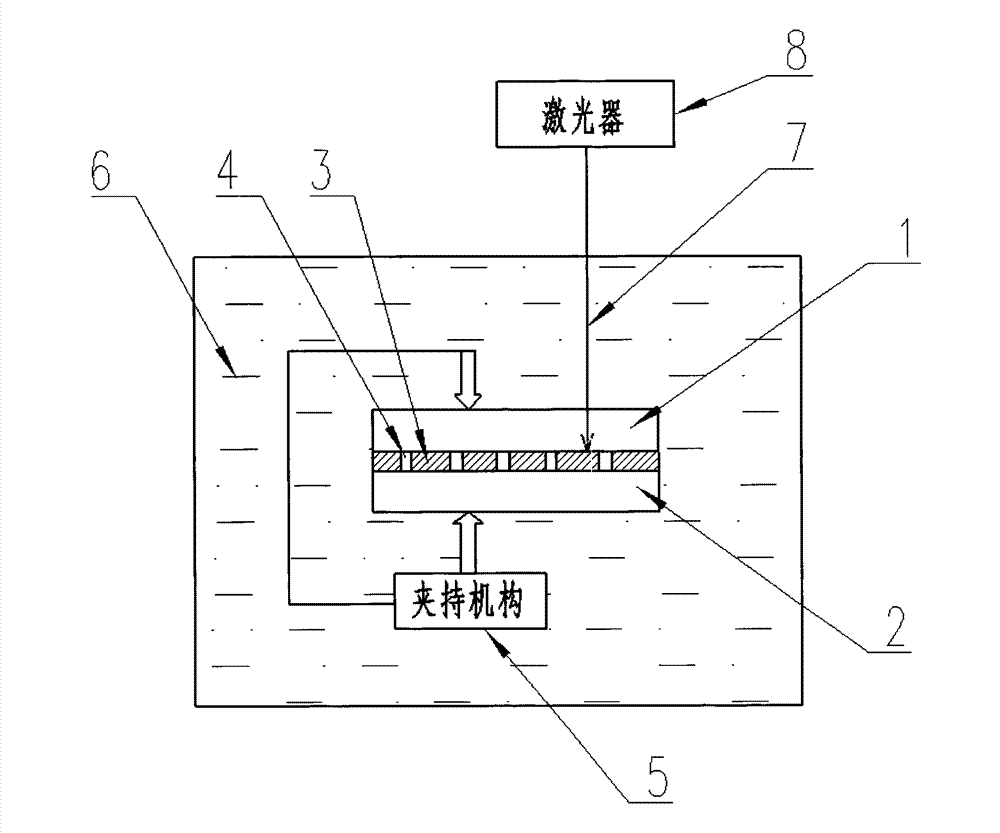Laser transmission welding method for thermoplastic plastics
A technology of laser transmission welding and thermoplastics, which is applied in the field of laser welding, can solve the problems of non-conductivity, thermal conductivity change, difficulty in optimizing the range of laser welding process parameters, and two workpieces can no longer be separated, etc., to achieve enhanced strength and good conductivity / insulation effect
- Summary
- Abstract
- Description
- Claims
- Application Information
AI Technical Summary
Problems solved by technology
Method used
Image
Examples
Embodiment 1
[0035] Such as figure 1 As shown, the invention provides a kind of laser transmission welding method of thermoplastics, comprising the following steps:
[0036] (1) A welding frame 3 is placed between two upper hard plastics 1 and lower hard plastics 2 to be welded; the upper hard plastic 1 is a thermoplastic that can transmit laser beams, and the welding frame 3 It is a hard material that can absorb laser beams. In the present embodiment, the upper hard plastic 1 and the lower hard plastic 2 adopt polyethylene terephthalate (PET) with a thickness of 10mm, and the lower hard plastic 2 adopts polyethylene terephthalate (PET). Carbonate (PC) with a thickness of 10mm; the welding skeleton 3 adopts a thin copper sheet with a thickness of 1mm; the melting point of the welding skeleton 3 is higher than that of the upper hard plastic 1 and the lower hard plastic 2, and the welding skeleton 3 There are several through holes 4; the position, size and shape of the through holes 4 can b...
Embodiment 2
[0045] The invention provides a thermoplastic laser transmission welding method, comprising the following steps:
[0046] (1) A welding frame 3 is placed between the two upper hard plastics 1 and the lower hard plastic 2 to be welded; the upper hard plastic 1 is a thermoplastic that can transmit laser beams; the welding frame 3 It is a hard material that can absorb laser beams, the melting point of the welding skeleton 3 is higher than the melting point of the upper hard plastic 1 and the lower hard plastic 2, and several through holes 4 are arranged on the welding skeleton 3; in this embodiment The upper hard plastic 1 is made of polycarbonate (PC) with a thickness of 50mm; the lower hard plastic 2 is made of polybutylene terephthalate (PBT) with a thickness of 100mm, and the welding skeleton 3 is made of aluminum oxide with a thickness of 0.5mm Ceramics;
[0047] (2) The upper hard plastic 1 and the lower hard plastic 2 are clamped by the clamping mechanism 5, that is, pres...
PUM
| Property | Measurement | Unit |
|---|---|---|
| Thickness | aaaaa | aaaaa |
| Thickness | aaaaa | aaaaa |
| Thickness | aaaaa | aaaaa |
Abstract
Description
Claims
Application Information
 Login to View More
Login to View More - R&D
- Intellectual Property
- Life Sciences
- Materials
- Tech Scout
- Unparalleled Data Quality
- Higher Quality Content
- 60% Fewer Hallucinations
Browse by: Latest US Patents, China's latest patents, Technical Efficacy Thesaurus, Application Domain, Technology Topic, Popular Technical Reports.
© 2025 PatSnap. All rights reserved.Legal|Privacy policy|Modern Slavery Act Transparency Statement|Sitemap|About US| Contact US: help@patsnap.com

